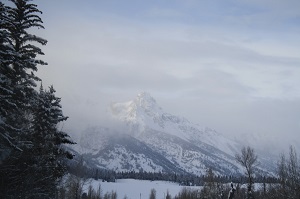Editor’s Note: Twenty-one students from Principia School recently traveled from St. Louis, Missouri to the Tetons for a week at Tetons Science Schools exploring what it means to be a naturalist through science and art. Earlier this week, we featured the reflections of their science teacher, Lynne Scott. Today, we’re excited to share the writing, photos, and artwork of several of the students themselves.

Stanton Ott
The TSS trip gave me a chance to reconnect with the solitude and peace that nature offers. We humans tend to try to make our lives as comfortable and entertaining as possible with screens, plastics, and fake flavors.
The Tetons gave me the opportunity to realize the work I need to do on myself. I fervently believe that to gain true contentment one must live as nature intended. Not in a hut in the woods somewhere, but rather appreciating what we are given, and realizing what is most important in our lives. It is a necessity for many to live in an urban environment – just know that there is more than buildings and cars. TSS gave us a taste of the wild.
 Cicely Williams
Cicely Williams
The more I learned and saw in the Tetons, the more I grew to love and be grateful for the beauty of nature. My watercolors allowed me to further develop my artistic ability and deepen this appreciation of nature. The symbolic meaning of the brown window frames is to encourage viewers to enjoy the outdoors and not be limited and constrained within walls. Windows only give us a cropped view of the world; so much more can be seen from outside.
 Christina Redington
Christina Redington
When being in this community, we embraced every activity we did. In the actions of doing these activities, we faced adversity and went above and beyond. For example, in cross-country skiing, some of the people in my group including myself fell down and struggled to get back up. But we did get back up, and we broke the boundaries of our fear.
 Caelin Wampole
Caelin Wampole
In my southern Illinois/Missouri mind where everything is fields and pavement, and there is nothing bigger than a coyote that isn’t a farm animal, I had somehow come to assume that there were no truly wild places left in the world, let alone the United States. Humanity had either stomped them out or made them tame and safe for people to wander through.
I learned that there are actually still giant herds of animals that roam around freely, and that a mountain range is not just a single file line of spiky mountain tops all set up in a row. I learned that there are still wild places.
 Zoe Wade
Zoe Wade
Standing on the hill with everyone around me, I pictured being up there alone. The idea shocked me, and I found it difficult to not be afraid, a small out-of-place piece in this huge wild puzzle. I realized all I had to do was love. Love the place, the nature, and all the things that would protect me. I was safe and small and all the things I’d been dealing with were insignificant. It was relieving and deep, and I wasn’t afraid anymore.
Marshall Fielding
Finding Our Wildernesses
You do not have to find the most beautiful place on earth,
the most quiet or the most untouched.
You only have to seek as the owl does, or turn your ears and raise your nose like the deer.
Tell me about your fear of being alone, even when surrounded by others, and I will share the fears I once carried.
While you have been searching for beauty in your world the clouds and sun have been painting the sky around you.
The winds have been dancing with the trees.
Between the hills and mountains of snow the beautiful burnt orange Fox glides past you.
Ravens fill the sky’s freeways and
Roars so fierce they make the woods tremble echo the woods.
Whoever you are and wherever you are, when you listen you will hear the earth, whispering through all her children, you’re never alone, all wilderness will always be your home.
And you will always find a realm of love in those wild places.



